VAM: Building the Foundations of Sustainable Agriculture by Strengthening Roots, Enriching Soil and Protecting the Planet

Saritha S.S (Scientific Officer), Sunimol Sebastian (Scientific Assistant), Aswathy Elizabeth Jacob (Scientific Assistant)
The heterogeneous group of microorganisms and their impact on natural ecosystem occupies a key position in the world of biology (Wath, 2006). Microorganisms play a significant role in maintaining the environmental functions of soil and without the complex heterogeneous activities of microorganisms, soil would not exist (Buscot& Varma, 2005),(Dobrovol et al., 2015). Soil comprises the most diversified microbial communities found in any environment on the planet (Younas et al., 2022). Through nutrient cycling and carbon(C) sequestration, the soil microbial community contributes to the maintenance of soil fertility and mitigation of global warming (Hemkemeyer et al., 2021).
The over exploitation of chemical fertilizers made negative impacts on environment, beneficial microorganisms as well as human beings and animals, causing a shift towards the use of bio fertilizers (Yapa et al., 2022). The need to reduce the use of agro chemicals and the favour of customers towards more nutritious food, led to a sustainable shift towards biofertilizer products to be produced and used in agriculture (Joshi & Gauraha, 2022). The interaction between plants and microorganisms is the most key component in the enhancement of productivity and biofertilizers have a great potential to enhance the productivity of agricultural lands (Mahanty et al., 2017). Biofertilizers are natural living microbial inoculants. They include AM fungi, Rhizobium, Azotobacter, Azospirillum, Cyanobactyeria, Azolla, Phosphate solublizing microorganisms (PSM), Silicate solublizing bacteria (SSB), Plant growth promoting rhizobacteria (PGPR) (Kumar et al., 2017).
Of the various microorganisms present in the soil, some form symbiotic association with the roots of higher plants (Paracer & Ahmadjian, 2000). Terrestrial fungi are assumed to have emerged around the same time as land plants. Beyond their role as saprophytic fungi, some of them formed close association with the roots of plants reinforcing their ability to absorb nutrient elements. This becomes a symbiotic association known as mycorrhizae (Dighton, 2009). The existence of arbuscules in a land plant in early Devonian period provides evidence that mycorrhizae were established 400 million years ago. This suggests that nutrient transfer mutualism may have been established when plants invaded the land (Remy et al., 1994).
In addition to improving mineral nutrition, mycorrhizae provide greater resistance to soil pathogens, increase tolerance to drought stress and reduce sensitivity to toxic substances present in the soil. Arbuscular, ecto, ectendo, monotropoid, arbutoid, ericoid and orchid mycorrhizae are the seven types of mycorrhizae described. (Siddique & Pichtel, 2008). Of these mycorrhizae, Arbuscular mycorrhizae is the most common. Gymnosperms, angiosperms, sporophytes of pteridophytes and gametophytes of hepatics are the plants that form Arbuscular Mycorrhizae (Smith & Read., 2010). As the AMF provide the host with water, nutrients and pathogen protection, they are considered as natural bio-fertilizers (Berruti et al., 2016).
The AM fungi previously belonged to Zygomycota, are now placed into the new phylum Glomeromycota based on molecular, morphological and ecological characteristics (SCHÜßLER et al., 2001).
AM Fungi as Biofertilizers, can control soil erosion, enhance phytoremediation and eliminate other harmful microorganism (Igiehon & Babalola, 2017).
The AM fungi consist of characteristic structures, vesicles and arbuscules. Arbuscules which are the sites of exchange for phosphorous, carbon, water and other nutrients occur within the cortical cells of plant roots and vesicles which are storage structures are located within or between the cells. Along with these a wide range of intraradical structures, including well developed hyphal coils are also present (Smith & Read, 2010).
The pre-symbiosis of VAM fungi consists of three stages: spore germination, Hyphal growth, host recognition and aspersorium formation (Abiala et al.,2013). The thick walled, multinucleated spores are long term survival structures and are the best sources of inoculum.
The AM fungal symbiosis improves the plant’s resistance to biotic and abiotic stresses and through external hyphal network, it improves the structure of soil making it an integral component of agricultural system (Harrier & Watson, 2003).
Therefore the present study aims to evaluate the effect of VAM on plant growth and the identification of VAM association in the infected roots.
MATERIALS AND METHODS
- VAM Inoculum
ABTEC VAM (Mycorrhiza) containing 20 spores per gram (Figure 1: A, B)My Crops
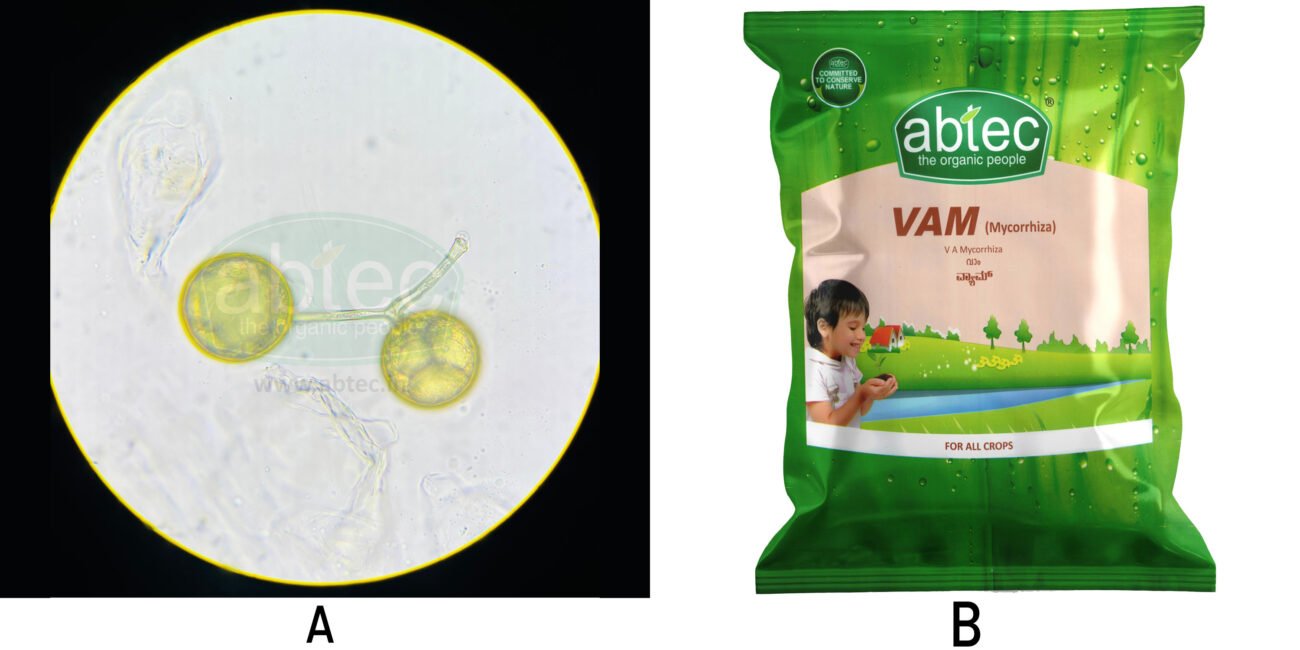
Figure 1
A : ABTEC VAM spores
B : ABTEC VAM
II. Test Plants
Sorghum seeds were surface sterilized and placed on a moist filter paper in a controlled condition for germination. The uniformly germinated seeds were selected for planting (Figure 2).
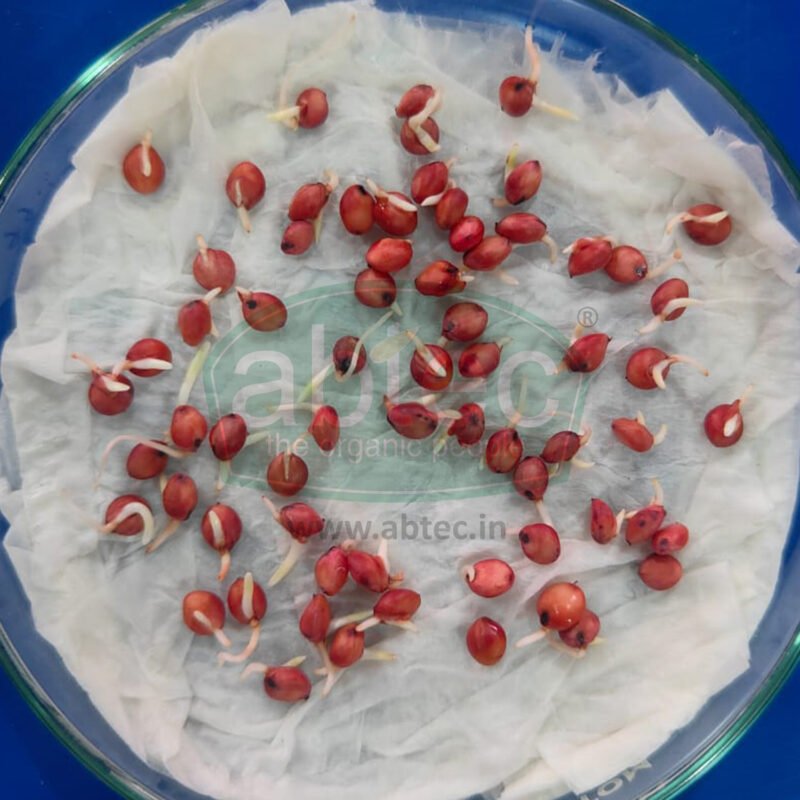
Figure 2: Germinated sorghum seeds
ABTEC POTTING MIXTURE which was sterilized and filled up to 3/4th of a glass container (12×12×12 dimension)served as experimental pots. Six such containers were selected. One set of three as Test (Figure 3 –A) and the other as control (Figure 3-B) with two replicates used for each. Six of the germinated seeds were selected, small 6 depressions were made in the potting mixture, and ABTEC VAM inoculum was added, followed by the planting of germinated seeds. Both the test and control were covered with polythene sheets and kept for observation. Observation was done at an interval of 30 days for 3 months.
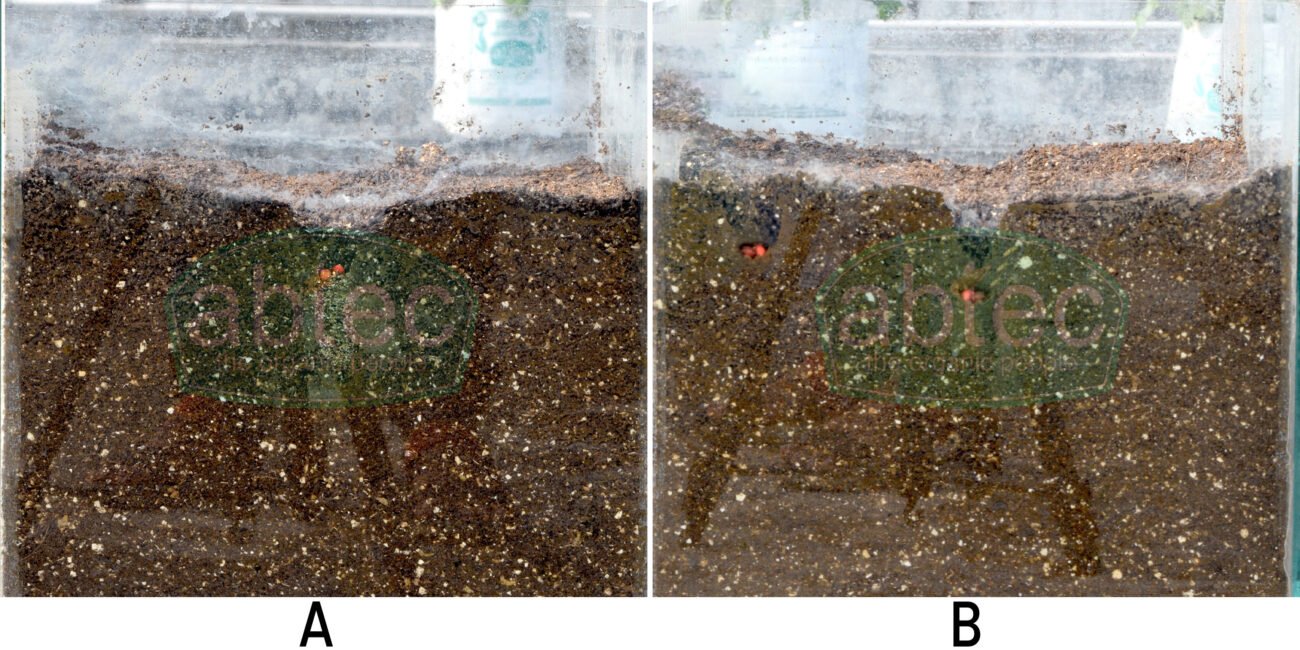
Figure 3
A: Test experimental pot
B: Control experimental pot
III. Parameters Measured
Plant growth, Total plant biomass, Root biomass and Quantitative estimation of Vesicular Arbuscular Mycorrhizal infection on root was observed at an interval of 30 days using standard procedures.
RESULTS
Plant Growth
When compared to control (Figure 4: B) leaves were lush green, broader and more abundant in the test plants. Multiple shoots per plant were high, stems appeared relatively thicker, taller and well developed (Figure 4: A). Roots appeared denser and significantly longer. Lateral root expansion was also observed and the root mass was greater (Figure 4: C). Overall the plants showed strong upright growth.
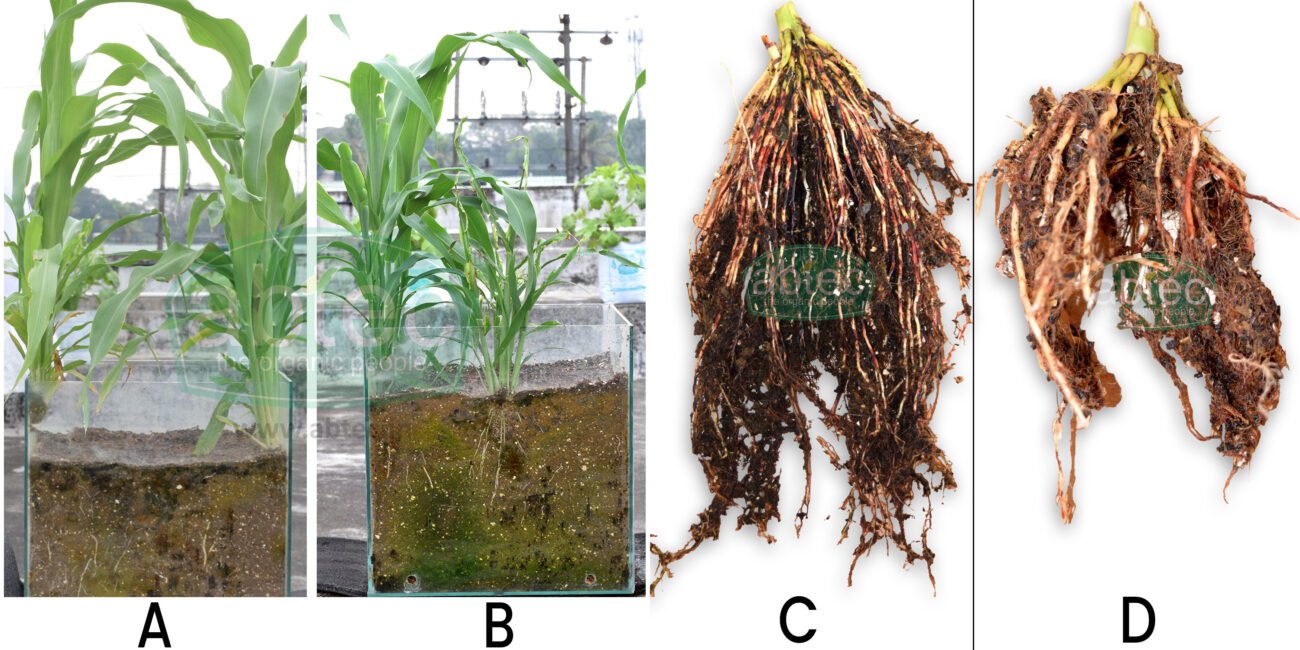
Figure 4
A: Test plant
B: Control plant
C: Root of test plant
D: Root of control plant
The total plant weight of test was 269.02 and control was 211. Root weight of test was 96.80 and control was 60.42. When compared to control the total plant weight and root weight of test plants, which were treated with ABTEC VAM inoculum were much higher.
Quantitative estimation of Vesicular Arbuscular Mycorhizal Infection on Roots
The quantitative estimation of Vesicular-arbuscular mycorrhizal colonization demonstrated an evident difference between the control and the plants treated with ABTEC VAM inoculum. The test plant showed 80% of root colonization (Figure 5 :A) and the control plant showed no signs of colonization (Figure 6).
The colonized roots showed the presence of Hyphae (Figure 5: D (h)), Arbuscules which are the site of bidirectional transfer of nutrients between VAM and host plants (Figure 5:B (a)) and Vesicles which act as storage organs or resting spores (Figure 5 :C (v)). This shows the active colonization of mycorrhizal fungi in the treated plants.

Figure 5: Various VAM fungal structures associated with roots,
A: VAM fungi colonized root bit, B: root bit showing arbuscules (a), C:vesicle (v),
D: intraradical hyphae (h)
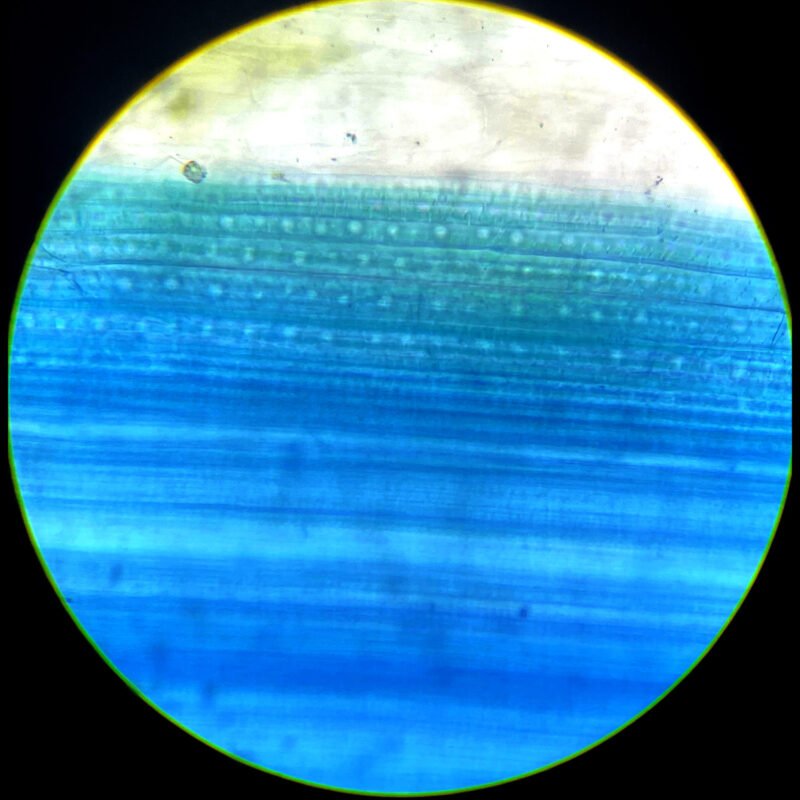
Figure 6 – Root bit showing no signs of VAM colonization
This clearly suggests that ABTEC VAM inoculum significantly enhances root colonization and there by promoting the plant growth, confirming its potential to be used as biofertilizer in regenerative agriculture.
Recommended Products
-
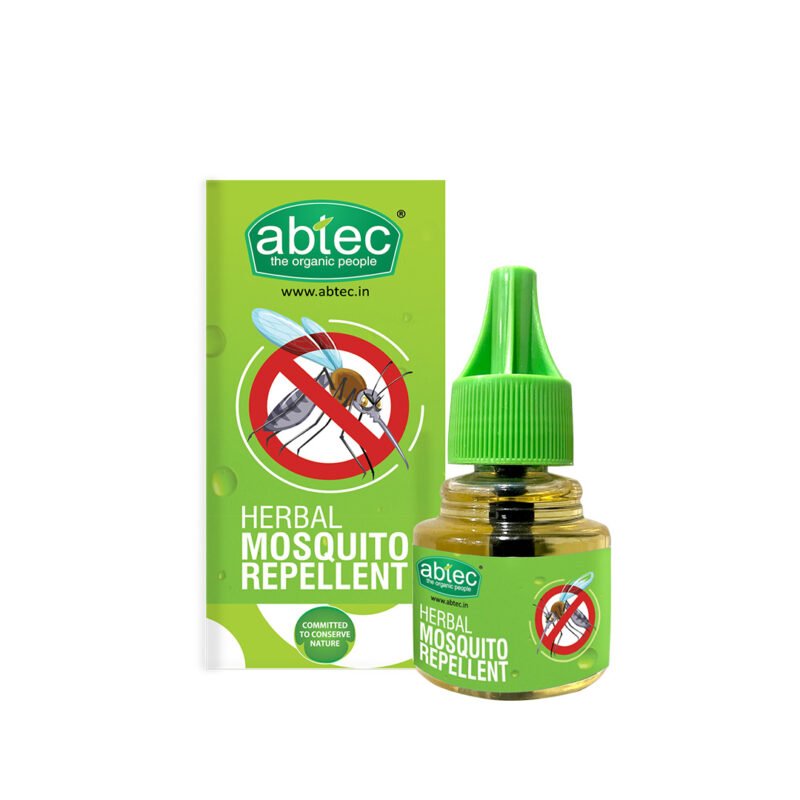 ABTEC Herbal Mosquito Repellent 50ml
ABTEC Herbal Mosquito Repellent 50ml
₹99.00Original price was: ₹99.00.₹95.00Current price is: ₹95.00. -
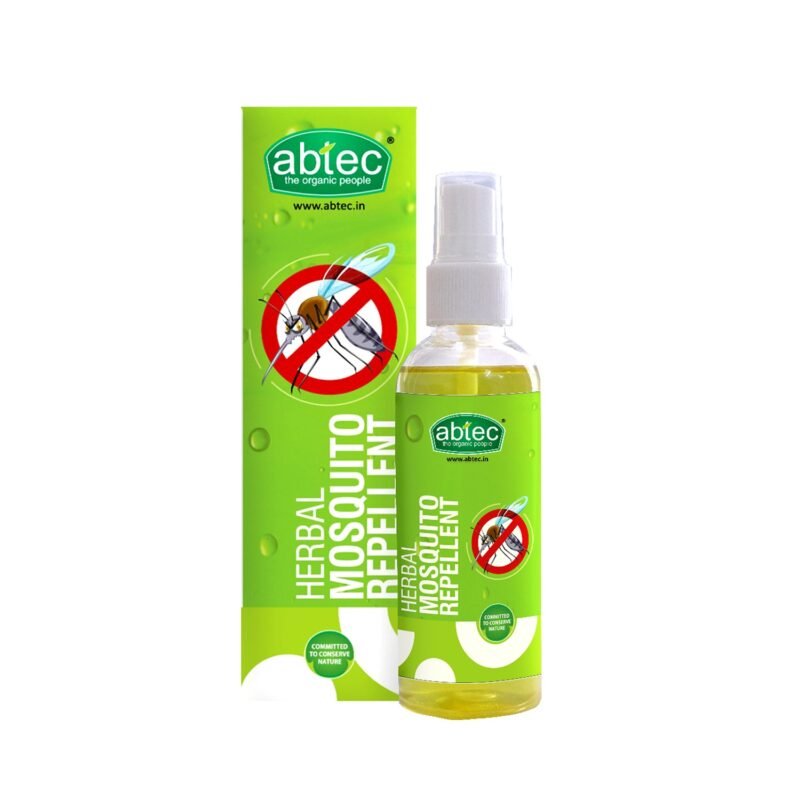 ABTEC Herbal Mosquito Repellent 100ml
ABTEC Herbal Mosquito Repellent 100ml
₹240.00Original price was: ₹240.00.₹235.00Current price is: ₹235.00.

